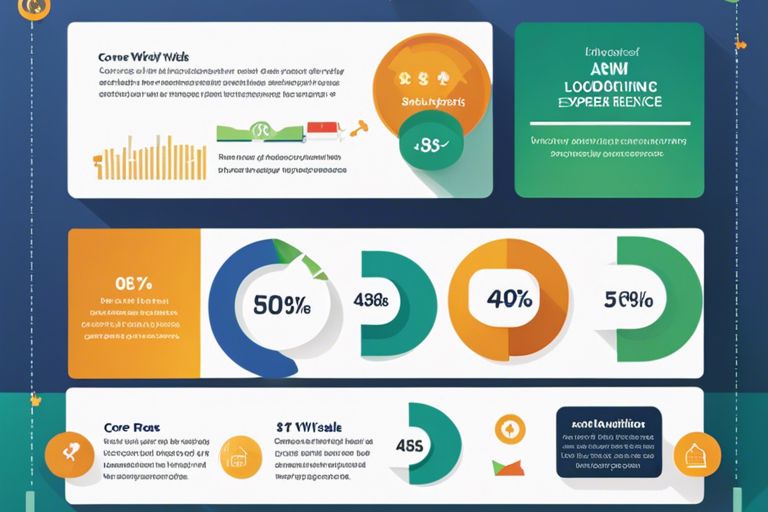As I probe the latest Chrome User Experience Report (CrUX) data, I’m excited to share with you the significant performance gains that websites have experienced across the board in all Core Web Vitals (CWV) metrics. With Google’s Page Experience Ranking Factor heavily influenced by CrUX data, it’s imperative to understand the impact of CWV on your website’s ranking. In this post, I’ll break down the key takeaways from the June 2024 CrUX dataset, including the changes to Interaction To Next Paint measurements, and what they mean for your website’s performance and search engine ranking.
Key Takeaways:
- CWV Performance Scores Improve: The June 2024 Chrome User Experience Report (CrUX) shows that websites have experienced an averaged improvement in all Core Web Vitals (CWV) website performance scores, with modest percentage increases across the board.
- CrUX Influences Page Experience Ranking Factor: The CrUX report is used to inform Google’s Page Experience Ranking Factor, making it an important metric for website publishers to monitor and improve, as it can impact website ranking and user experience.
- Changes to INP Measurements: Chrome has made changes to how Interaction to Next Paint (INP) is measured, making it more accurate and potentially leading to improved scores for sites that were previously penalized for using certain types of popups.
Understanding CWV and Google Page Experience Ranking Factor
To fully grasp the impact of Core Web Vitals (CWV) on Google’s Page Experience Ranking Factor, it’s vital to understand what CWV is and how it affects your website’s ranking.
What is CWV?
With the rise of user-centric metrics, Core Web Vitals (CWV) has become a crucial aspect of Google’s Page Experience Ranking Factor. CWV is a set of metrics that measure a website’s performance and user experience, focusing on loading speed, responsiveness, and visual stability.
How does CWV impact Google Page Experience Ranking Factor?
Factor in the importance of user experience, and you’ll see why CWV plays a significant role in Google’s Page Experience Ranking Factor. CWV metrics, such as Largest Contentful Paint (LCP), Cumulative Layout Shift (CLS), and Interaction to Next Paint (INP), directly influence how users interact with your website, ultimately affecting your ranking.
Ranking high in search engine results pages (SERPs) is not just about algorithms; it’s also about providing an exceptional user experience. By optimizing your website’s CWV, you can improve user engagement, increase conversions, and boost your online presence. According to Google’s documentation, the data collected by CrUX is used to inform the page experience ranking factor, making CWV a critical component of your website’s success.
The Importance of CrUX Dataset
While understanding the impact of CWV on Google’s Page Experience Ranking Factor, it’s crucial to discuss the significance of the Chrome User Experience (CrUX) dataset.
What is CrUX Dataset?
With the CrUX dataset, you get actual Core Web Vitals performance scores measured in Chrome browsers when visiting websites. The data comes from browsers that were voluntarily opted-in to report website performance metrics. This publicly available dataset is used by PageSpeed Insights and third-party tools, providing valuable insights into website performance.
How does CrUX influence Page Experience Ranking Factor?
CrUX plays a crucial role in informing Google’s Page Experience Ranking Factor. As stated in Google’s overview documentation, “The data collected by CrUX is available publicly through a number of Google tools and third-party tools and is used by Google Search to inform the page experience ranking factor.”
Ranking high in search engine results pages (SERPs) is not the only benefit of a good CrUX score. Improving your website’s performance can also lead to increased conversions, ad clicks, and overall user satisfaction. By leveraging the CrUX dataset, you can gain a competitive edge and optimize your website for better performance and user experience.
June 2024 CrUX Report Highlights
Unlike previous reports, the June 2024 Chrome User Experience Report (CrUX) reveals a promising trend of incremental improvements in Core Web Vitals (CWV) scores across the board.
Incremental improvements in CWV scores
An analysis of the CrUX dataset shows that websites have made modest but significant gains in their CWV scores. Specifically, the average origin scores for Largest Contentful Paint (LCP), Cumulative Layout Shift (CLS), and Interaction to Next Paint (INP) have all seen increases, with 51.0% of sites now having good LCP, CLS, and INP scores.
Changes to INP measurements
June’s CrUX report also highlights changes to how Interaction to Next Paint (INP) is measured, making it more accurate and potentially benefiting websites with dialog modals (popups).
Reportedly, the Chrome team has been working on improving efficiencies in Chrome’s handling of Core Web Vitals metrics, leading to changes in INP measurements. These changes now better handle the use of basic modal dialogs, such as alerts, confirms, and prints, which were previously not counted as presentation feedback for INP. As a result, websites that use these modal dialogs may see improved INP times.
Largest Contentful Paint (LCP)
Many website owners and developers are still unclear about the impact of Core Web Vitals (CWV) on Google’s Page Experience Ranking Factor. As I dug deeper into the topic, I found a fascinating study by Perficient that sheds light on What Is the Impact of Core Web Vitals on Ranking?. But before we explore the specifics, let’s break down one of the key CWV metrics: Largest Contentful Paint (LCP).
Definition and importance of LCP
Defining LCP is crucial to understanding its significance. LCP measures how quickly the main content of a webpage loads, focusing on the largest image or content block visible in the browser’s viewport. This metric is important because it directly affects user experience, as a slow-loading page can lead to frustration and higher bounce rates.
Average origin scores for LCP
With the latest CrUX dataset, we can see that 63.4% of origins (entire websites) have good LCP scores, marking a 2.0% increase from the previous dataset.
Average LCP scores are a vital indicator of a website’s overall performance. A good LCP score indicates that your website is providing a seamless user experience, which can positively impact your Page Experience Ranking Factor. As I analyzed the CrUX dataset, I noticed that popular content management systems like WordPress are continually improving their LCP scores with each new version release, demonstrating the importance of prioritizing website performance.
Cumulative Layout Shift (CLS)
All website owners strive to provide a seamless user experience, and Cumulative Layout Shift (CLS) is a crucial aspect of achieving this goal.
Definition and importance of CLS
The Cumulative Layout Shift metric measures how long it takes for a web page’s layout to become stable without elements jumping and shifting on the page. This is necessary because sudden layout shifts can be frustrating for users, leading to a higher bounce rate and negatively impacting your website’s overall performance.
Average origin scores for CLS
On a positive note, the June 2024 CrUX data shows that 77.8% of websites have good CLS scores, indicating that most websites are doing a great job of maintaining a stable layout.
This is a significant improvement, and it’s likely due to the increased focus on user experience and web performance optimization. As a website owner, it’s necessary to ensure that your website’s layout is stable and doesn’t cause any unexpected shifts, which can be achieved by optimizing images, using responsive design, and minimizing DOM elements.
Interaction to Next Paint (INP)
Keep in mind that Interaction to Next Paint (INP) is a crucial aspect of Core Web Vitals (CWV), and understanding its impact on Google Page Experience Ranking Factor is vital for website owners and developers.
Definition and importance of INP
Any website that aims to provide a seamless user experience should prioritize INP. It measures how long it takes for a web page to become responsive to user interactions, ensuring that users can engage with your website without any frustrating delays.
Average origin scores for INP
The importance of INP is reflected in the average origin scores, which show a significant improvement of 1.1% in the June 2024 CrUX dataset, with 84.1% of origins having good INP scores.
This improvement is a testament to the efforts of website owners and developers who have been working to optimize their websites for better user interactions. As a result, users can now enjoy faster and more responsive interactions with websites, leading to a better overall experience.
Changes to INP measurements
Next, it’s important to note that Chrome made changes to how INP is measured, making it more accurate and fairer to websites that use dialog modals (popups). These changes have contributed to the positive trend in INP scores.
Interaction to Next Paint now better handles the use of basic modal dialogs, such as alert, confirm, and print, which were previously not counted as presentation feedback for INP. This update ensures that websites using these modal dialogs are no longer penalized with high INP values, leading to more accurate scores.
Percentage of Sites with Good CWV
Now, let’s explore the numbers. According to the June 2024 CrUX data, a significant percentage of sites have achieved good CWV scores.
Definition and importance of good CWV
To clarify, a “good” CWV score means that a site has passed all three Core Web Vitals metrics: Largest Contentful Paint (LCP), Cumulative Layout Shift (CLS), and Interaction to Next Paint (INP). Having good CWV scores is crucial because it directly impacts your website’s user experience and, subsequently, your Google Page Experience Ranking Factor.
Average origin scores for good CWV
Good news! The average origin scores for good CWV have seen a notable increase across all three metrics. Specifically, 63.4% of sites have good LCP, 77.8% have good CLS, and 84.1% have good INP.
Another interesting observation is that the percentage of sites with good CWV scores across all three metrics has increased to 51.0%. This suggests that website owners and developers are taking steps to improve their site’s performance and user experience.
Impact of CWV on Page Experience Ranking Factor
Despite the many factors that influence Google’s Page Experience Ranking Factor, Core Web Vitals (CWV) play a significant role in determining a website’s overall user experience.
How CWV Affects Page Experience
Affecting the way users interact with your website, CWV metrics such as Largest Contentful Paint (LCP), Cumulative Layout Shift (CLS), and Interaction to Next Paint (INP) provide a comprehensive picture of your website’s performance. By optimizing these metrics, you can significantly improve your website’s page experience, leading to increased user engagement and satisfaction.
Importance of CWV for Website Ranking
Importantly, CWV metrics are not just limited to improving user experience; they also have a direct impact on your website’s ranking. As Google’s CrUX report shows, websites with good CWV scores are more likely to rank higher in search engine results pages (SERPs).
Factor in the fact that CWV metrics are publicly available through tools like PageSpeed Insights and third-party tools, and you’ll realize that optimizing your website’s CWV scores is crucial for staying ahead of the competition. By prioritizing CWV optimization, you can not only improve your website’s user experience but also boost your search engine rankings and drive more traffic to your site.
Benefits of Improving CWV
To reap the rewards of a better user experience and improved search engine rankings, it’s necessary to understand the benefits of improving your Core Web Vitals (CWV) scores. As Google continues to emphasize the importance of CWV in its Page Experience Ranking Factor, it’s crucial to stay ahead of the curve.
As Are Core Web Vitals A Ranking Factor?, the answer is yes, and it’s becoming increasingly important to prioritize CWV optimization.
Improved conversions and ad clicks
Improved page loading times and a smoother user experience can significantly boost conversions and ad clicks. When your website loads quickly and is easy to navigate, users are more likely to engage with your content, leading to higher conversion rates and increased revenue.
Enhanced user experience
Experience a significant improvement in user satisfaction by optimizing your CWV scores. A faster and more responsive website leads to higher user engagement, reduced bounce rates, and increased time spent on your site.
A well-optimized website not only improves user experience but also sets your brand apart from competitors. By prioritizing CWV optimization, you can create a seamless and enjoyable experience for your users, leading to increased loyalty and trust in your brand.
Popular Content Management Systems and CWV
Your website’s performance is crucial in today’s digital landscape, and content management systems (CMS) play a significant role in achieving optimal Core Web Vitals (CWV) scores. As the latest CrUX report shows, popular CMS are continually improving their CWV performance.
WordPress and its efforts to improve CWV
With each new version release, WordPress is making positive strides in improving its CWV scores. As one of the most widely used CMS, WordPress’s efforts are crucial in helping website owners achieve better page experience ranking factors.
Other popular CMS and their CWV efforts
WordPress isn’t the only CMS working to improve its CWV performance. Other popular CMS, such as Joomla, Drupal, and Magento, are also focusing on optimizing their platforms for better CWV scores.
Understanding the importance of CWV, these CMS are implementing various strategies to improve page loading speeds, reduce layout shifts, and enhance overall user experience. By doing so, they’re enabling website owners to provide a better experience for their users, which in turn can positively impact their page experience ranking factors.
How to Improve CWV Scores
After understanding the importance of Core Web Vitals (CWV) and their impact on Google’s Page Experience Ranking Factor, the next step is to improve your website’s CWV scores. According to Google, “The data collected by CrUX is available publicly through a number of Google tools and third-party tools and is used by Google Search to inform the page experience ranking factor.” A good CWV score can not only improve your search engine rankings but also enhance user experience, leading to increased conversions and ad clicks. If you’re concerned about how Core Web Vitals can impact immediate loss in rankings, check out this thread.
Optimizing Images and Content
On average, images account for around 60% of a webpage’s total file size. Optimizing images and content is crucial to improving your Largest Contentful Paint (LCP) score. Ensure that you’re using compressed images, lazy loading, and optimizing content delivery networks (CDNs) to reduce the load time of your webpage.
Minimizing Layout Shifts
Layout shifts can be frustrating for users and negatively impact your Cumulative Layout Shift (CLS) score. To minimize layout shifts, ensure that you’re setting explicit dimensions for images and videos, using CSS grid or flexbox for layouts, and avoiding inserting content above existing content.
Images and videos without explicit dimensions can cause layout shifts, so make sure to set them explicitly. Additionally, using CSS grid or flexbox for layouts can help prevent layout shifts by creating a more predictable layout structure.
Enhancing Interaction to Next Paint
To improve your Interaction to Next Paint (INP) score, focus on reducing the time it takes for your webpage to become interactive. Ensure that you’re using efficient JavaScript code, minimizing main thread work, and optimizing server response times.
Understanding how users interact with your webpage is crucial to improving your INP score. Analyze user behavior, identify areas of improvement, and optimize your webpage accordingly. By reducing the time it takes for your webpage to become interactive, you can enhance user experience and improve your INP score.
Tools for Evaluating CWV Performance
For evaluating Core Web Vitals (CWV) performance, you’ll need the right tools to help you identify areas for improvement and track your progress over time.
PageSpeed Insights
Insights into your website’s performance are just a few clicks away with PageSpeed Insights. This free tool from Google provides detailed reports on your website’s CWV scores, including Largest Contentful Paint (LCP), Cumulative Layout Shift (CLS), and Interaction to Next Paint (INP). You’ll also get actionable recommendations for improving your website’s performance.
Third-party tools for CWV evaluation
One of the benefits of using third-party tools is that they can provide a more comprehensive view of your website’s performance. These tools often offer additional features, such as competitor analysis and customizable reporting, that can help you optimize your website for better CWV scores.
To get the most out of these tools, I recommend using them in conjunction with PageSpeed Insights. By combining the data from multiple sources, you’ll get a more complete picture of your website’s performance and be able to identify areas for improvement more effectively. Some popular third-party tools for CWV evaluation include GTmetrix, Pingdom, and WebPageTest.
Conclusion
Conclusively, understanding the impact of Core Web Vitals (CWV) on Google’s Page Experience Ranking Factor is crucial for website owners and developers. With the latest CrUX data showing improvements in CWV scores, it’s clear that website performance is becoming a key focus area. By grasping the importance of CWV and how it influences the Page Experience Ranking Factor, you can optimize your website to improve user experience, drive conversions, and boost your online presence. Be mindful of, even small improvements can make a significant difference in today’s competitive digital landscape.
FAQ
Q: What is the significance of the Chrome User Experience Report (CrUX) in relation to Google’s Page Experience Ranking Factor?
A: The CrUX report is used by Google to inform the Page Experience Ranking Factor, making it an important metric for website publishers to track. The data is publicly available and can be used to evaluate performance, including competitor performance. While the influence of the Page Experience Ranking Factor may be on the lower side, it’s still important for reasons outside of algorithms, such as improving conversions and ad clicks.
Q: What are the Core Web Vitals (CWV) metrics, and how have they improved according to the June 2024 CrUX dataset?
A: The Core Web Vitals metrics include Largest Contentful Paint (LCP), Cumulative Layout Shift (CLS), and Interaction to Next Paint (INP). According to the June 2024 CrUX dataset, CWV website performance scores have incrementally risen across the board by modest percentages. Specifically, the average origin scores show improvements in LCP (63.4% with a 2.0% increase), CLS (77.8% with a 0.5% increase), INP (84.1% with a 1.1% increase), and the percentage of sites with good CWV (51.0% with a 2.3% increase).
Q: How did the changes to Interaction to Next Paint (INP) measurements impact the CWV scores, and what does it mean for websites with dialog modals?
A: The Chrome team made changes to how INP is measured, making it more accurate. Specifically, the new measurement now accounts for basic modal dialogs (popups), which were previously not counted as presentation feedback for INP. This change may have contributed to the positive trend in INP scores, particularly for websites that use dialog modals. As a result, these websites may see improved INP times.




